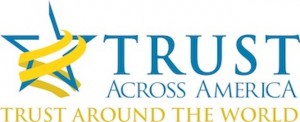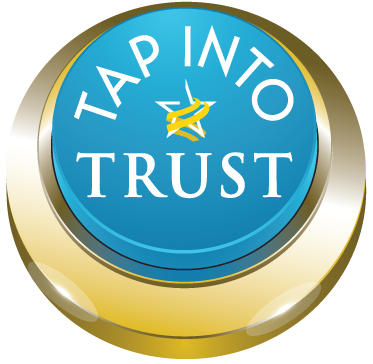Organizations and their leaders often find themselves caught in “trust and ethics traps.”
Jes Staley the newly appointed American CEO of the beleaguered British Barclays Bank is one such leader. In fact, as he recently announced in this BBC News Article “I do believe that trust is returning to our institution. But we will never rest, we are never done. We have to focus on building that trust every day.”
Eerily, Staley’s comments have a familiar ring. In the wake of the Libor scandal in 2012 the Bank’s new CEO, an insider named Antony Jenkins also spoke extensively about rebuilding trust. Yet in an all too common response when faced with a crisis of trust and ethics, the Board Chair John McFarlane recently passed blame to regulators for picking on the bank.
We asked our Trust Alliance members to weigh in on the steps Barclays new CEO should take to build trust and ethics, carrying on the legacy of his predecessor.
Leadership Momentum’s Elizabeth Doty emphasizes the importance of building on the company’s new purpose and values, by making clearer, stronger commitments to stakeholders:
Though outsiders can never know a company’s internal reality, Mr. Staley’s comments show that he recognizes that trust is earned by being trustworthy. It is also positive that Mr. Staley’s predecessor, Mr. Jenkins, clarified the company’s purpose and values, and outlined specific behaviors, such as “I honour my commitments.” Still, given the turmoil of repeated leadership changes and reorganization, Mr. Staley and his team are likely to face serious credibility challenges, regardless of their intent.
The purpose of a commitment is to reduce others’ uncertainty, so they feel less risk in trusting us. Making and keeping meaningful commitments is a powerful way to proactively demonstrate trustworthiness. Yet, despite Barclay’s clarification of its purpose and values, stakeholders are still left with their primary uncertainty: How will you make tradeoffs under pressure? “I see nothing to indicate rates and markets will not be rigged again in future or that schemes to enhance bank profits at customers’ expense…could not repeat,” posted one commenter. One solution is to make clearer, stronger commitments specifically related to the side-stepping stakeholders worry about. For example, Barclay’s could commit to doing whatever most contributes to a customer’s goals, or to a level playing field in the market. Though it takes courage, companies that put such a stake in the ground and learn how to deliver a) increase credibility by showing they understand stakeholders’ true risks, b) reduce the potential for mixed messages to staff, c) force themselves to innovate, and d) differentiate themselves in a way that is extremely difficult to emulate. The key will be not to underestimate the challenges of re-shaping their culture to get there.
Davia Temin, a leading reputation and crisis response consultant speaks of the trust challenges continuing to plague most of the largest global financial institutions years after the 2008 financial meltdown.
Rebuilding trust in financial institutions is a complex algorithm that can test the skills of the best financial engineering “rocket scientist.”
Far from simply making a pronouncement of one’s intent (although that can be the first step), the organization needs to first deconstruct all the elements that went into building trust in their particular firm in the first place, analyze all the things that went wrong, and then construct a plan to overcorrect the breaches. Because simply fixing them will not rebuild trust, it will only, maybe, stop the erosion.
But this is seriously hard work. Barclays, as most banks, has a number of critical audiences, each of whom needs a different set of fixes in order to begin to restore their trust. And some of those fixes are in direct conflict with others. Individual customers, shareholders, institutional clients, counterparties, regulators and legislators in every country in which they operate, and even the public at large must each feel that the bank puts THEIR INTERESTS in front of its own. Because it has been the self-dealing aspect of financial institutions’ behavior that did the most damage to their reputations and caused the greatest loss of trust.
So, to rebuild trust, Barclays and others will need to show their audiences that the bank puts them first…and that’s a hard thing to do and remain profitable. But it is almost impossible to make such a promise and then ignore it, or to fail in its announced attempt. So, now that Mr. Staley has thrown down the gauntlet, perhaps he can get his financial product rocket scientists to reverse-engineer all the elements that went into the losing of public trust, share them with us all, and then announce how he will redress them, one by one. That, indeed, just might work, and would be my prescription.”
And finally Bob Whipple of Leadergrow reminds us where trust starts in all institutions.
It sounds like a lot of problems have been swept under the rug for some time and are impacting all facets of Barclays. I applaud the resolve to rebuild trust in the bank and the candor at admitting the many unpopular steps it will take. My advice is to recognize that rebuilding a culture starts at the top and works its way down the organization. Establish an understanding that it is safe for people to tell you the things that are hard to say. Do not punish people when they bring up issues that are uncomfortable or difficult to address.
Similar to Barclays many organizations find themselves in trust traps because they hold on to the notion that trust and ethics are “soft skills.”
And because trust is ignored or taken for granted, its decline continues across all major institutions. Some of the warning signs of low trust include:
- Disengaged boards with minimal diversity- not only must the board be “on board” with the mission and vision of the organization but research, including our own points to a correlation between high trust organizations and gender diversity.
- Frequent crises- identifying core values, practicing and reinforcing them daily heads off many “would be” crises. Leaders who view trust as “soft” often find themselves spending the majority of their time putting out fires instead of improving their culture.
- Short-term profit maximization at all costs including layoffs and job cuts as a first line of defense- it’s not unusual for companies like Barclays to think the bleeding can be stopped by cutting jobs and divisions, but these are simply bandages and they never cure diseases.
- Decreasing CEO tenure and increasing compensation packages tied to quarterly earnings- try tying CEO compensation to some point in the future (3-5 years) and suddenly the focus changes from the short to the long term.
- Increasing regulation (and scrutiny from regulators) and larger legal and compliance departments- as we have discussed in the past, trust simply can’t be regulated. It’s voluntary.
Fortunately the most progressive organizations have begun to recognize the strategic advantages of a high trust culture.
- Fewer crises and the ability to recover more rapidly
- A large trust “bank account”
- Faster decision making and improved execution
- Higher employee engagement
- Higher customer loyalty and retention
- Greater innovation (high trust fuels high innovation, not the other way around)
- Increased long-term profitability
The trust and ethics crisis at Barclays will not end until insiders, beginning at the Board level, not only accept blame and take responsibility, but also put actionable measures in place to clean up the culture. Will Jes Staley be the CEO who turns Barclays around? Will he walk the trust he is talking? What do you think?
Tuning in to Trust & Ethics is a new monthly column of Trust Across America-Trust Around the World’s Trust Alliance compiled by Barbara Brooks Kimmel
Another version of this article first appeared on the FCPA Blog.
Part I: bit.ly/1Mp9LO7
Part II: bit.ly/1UcHiTJ
Copyright (c) 2016 Next Decade, Inc.


Recent Comments